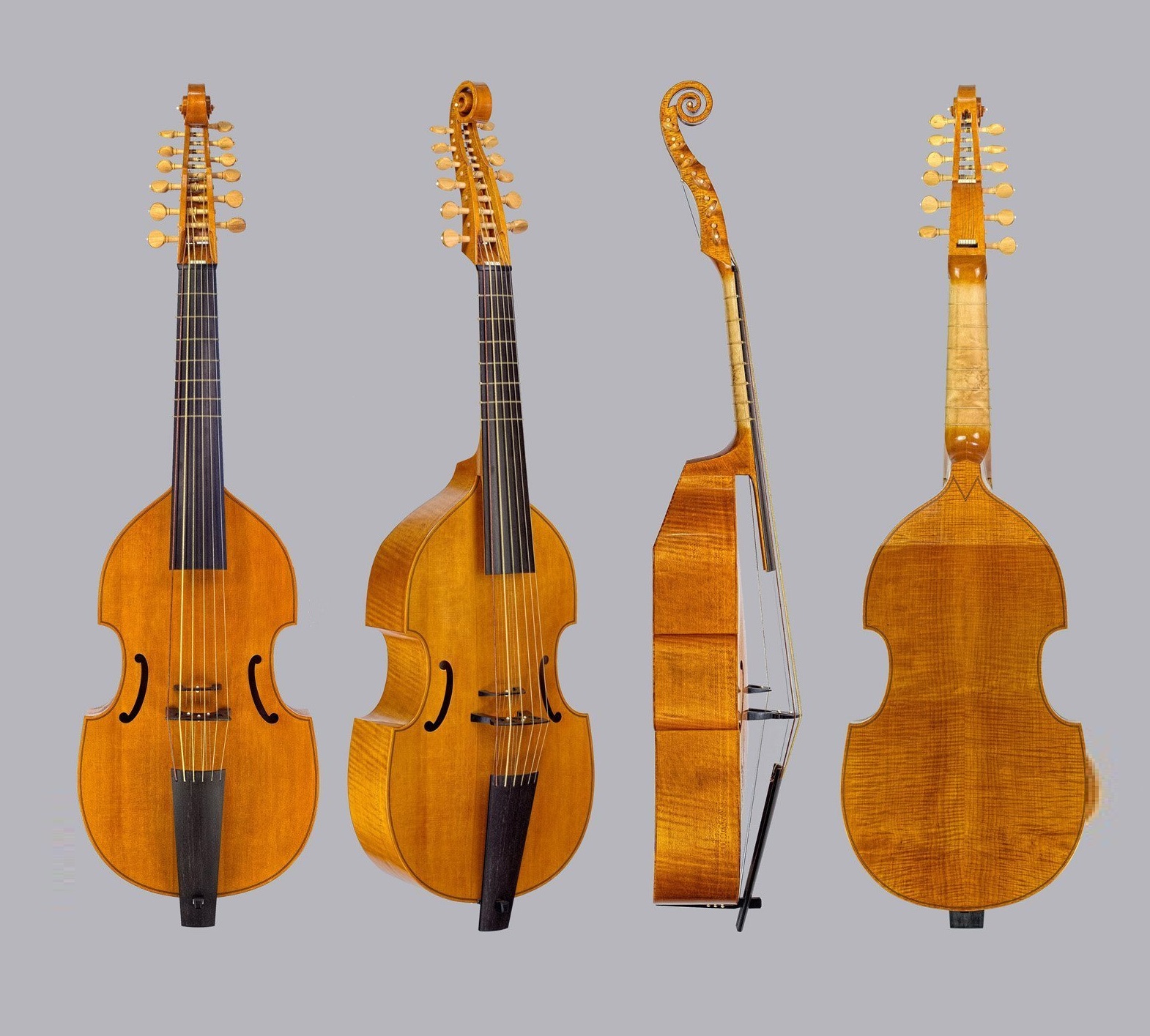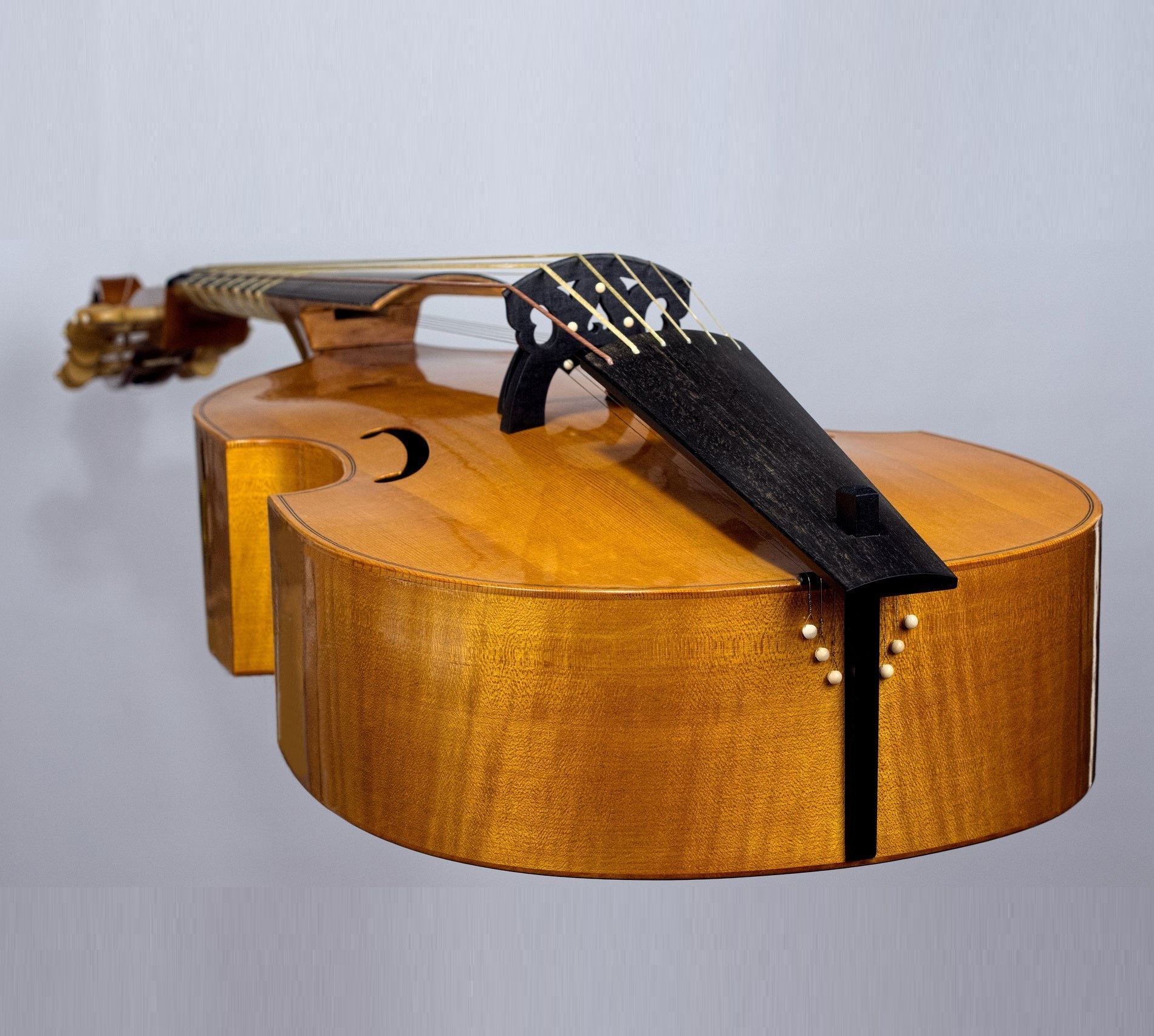Lyra viol
Bowed Instruments
Europe
Between 1001 and 1900 AD
Video
The Lyra viol is a bowed string instrument that was popular during the late Renaissance and early Baroque periods. It belongs to the family of viols, which are fretted and typically held between the legs when played. Unlike the standard bass viol, the Lyra viol was specifically designed for chordal playing, making it a favored instrument among musicians who specialized in complex harmonies and contrapuntal music. It was most commonly played solo but could also be incorporated into consort music.
Type of Instrument: The Lyra viol falls into the category of bowed string instruments. More specifically, it is a member of the viol family, distinguished from other viols by its tuning, playing technique, and repertoire. It is often associated with polyphonic solo music, where a single performer plays multiple voices simultaneously by using various bowing and fingering techniques.
History
The Lyra viol emerged in Europe, particularly in England, during the late 16th century and remained popular through the 17th century. Its development coincided with a growing interest in music that combined melodic and harmonic elements in solo performance. It was widely used by composers and musicians who sought to explore the instrument’s ability to sustain harmonies while also maintaining a clear melodic line.
The instrument was prominently featured in English consort music and was especially favored by court musicians and composers such as William Lawes, Tobias Hume, and Christopher Simpson. The Lyra viol was unique in its extensive use of alternate tunings, which facilitated the execution of chords and counterpoint. Though its popularity declined with the rise of the violin family and changes in musical styles, it remains a subject of interest for historically informed performances today.
Materials and Construction
The Lyra viol was traditionally constructed from fine woods such as spruce for the soundboard, maple for the back and sides, and ebony for the fingerboard. The instrument featured a flat back, sloping shoulders, and C-shaped sound holes, distinguishing it from the violin family, which typically has f-shaped sound holes and an arched back. The frets were made of gut and were tied around the fingerboard, allowing for microtonal adjustments. The strings were also made of gut, contributing to the instrument’s warm and resonant sound. The bridge was carefully designed to allow the player to execute both melodic and harmonic passages with ease.
Types of Lyra Viols
There were several variations of the Lyra viol, though most were based on the standard bass viol size. Some players experimented with different string configurations and tunings, leading to slight variations in the instrument’s design. The primary distinction lay in the tuning system rather than in significant differences in construction. Some tunings were meant for ease of chordal playing, while others emphasized melodic lines. The standard tuning was often similar to the bass viol but featured alternative scordatura (retunings) to accommodate different repertoires.
Characteristics
The Lyra viol shared many characteristics with other viols, but it also had distinct features that set it apart. These included:
Fretted Fingerboard: Like all viols, the Lyra viol had a fretted fingerboard, allowing for precise intonation.
Bowed Strings: It was played with a bow, often held underhand, which was different from the violin family’s overhand bow grip.
Multiple Tunings: A defining feature of the Lyra viol was its use of multiple tunings (scordatura), enabling the execution of chords and harmonic passages.
Chordal Playing: Unlike other viols, which were mainly used for melodic playing or consort music, the Lyra viol excelled in solo polyphonic music, allowing for self-accompaniment.
Warm and Resonant Tone: The gut strings and wooden construction contributed to a rich, warm sound, making it suitable for both introspective solo music and expressive consort pieces.
Sound Production
The Lyra viol produced sound through the friction of the bow drawing across the strings, causing them to vibrate. The sound was amplified by the hollow wooden body, which acted as a resonator. The instrument’s frets ensured clear pitch articulation, while its tuning system allowed for a variety of harmonic colors. The bow, made of wood and strung with horsehair, was often adjusted with the fingers to control tension, allowing for nuanced dynamic expression.
Playing Methods
Playing the Lyra viol required a combination of bowing and fingering techniques that differed from those used for the violin or cello. Some of the key playing methods included:
Underhand Bow Grip: Players typically held the bow with an underhand grip, which provided greater control over dynamics and articulation.
Chords and Double Stops: One of the Lyra viol’s primary functions was chordal playing, achieved through double stops and multiple string bowing.
Alternative Tunings: Many compositions required different tunings, and players frequently re-tuned their instruments to facilitate certain harmonic or melodic passages.
Fretted Fingering: The use of tied gut frets allowed for precise note placement and facilitated smooth transitions between notes.
Roles in Music
The Lyra viol occupied a unique position in Renaissance and Baroque music. While the standard bass viol was often used in ensemble settings, the Lyra viol was primarily a solo instrument. Its main roles included:
Solo Instrument: The Lyra viol was used extensively for solo compositions, particularly in England, where composers wrote detailed, expressive works for the instrument.
Harmonic Accompaniment: Unlike most other bowed instruments of the time, the Lyra viol could accompany itself with harmonic passages, making it a favorite among musicians who sought to create full textures in solo performance.
Consort Music: Though primarily a solo instrument, the Lyra viol could occasionally be incorporated into viol consorts, enriching the harmonic palette of the ensemble.
Court and Domestic Music: It was particularly popular in aristocratic and domestic settings, where musicians sought refined, intimate music for private performance.
Cultural Significance
The Lyra viol held a significant cultural role in early modern Europe, particularly in England, where it flourished during the late Renaissance and early Baroque periods. It was considered a sophisticated instrument, suitable for both professional musicians and well-educated amateurs. Its music was often associated with the intellectual and expressive ideals of the time, reflecting the intricate counterpoint and harmonic exploration valued in 17th-century England.
The instrument was also a symbol of artistic refinement, with many of its compositions featuring in manuscript collections owned by aristocrats and scholars. Its decline in popularity coincided with the rise of the violin, which favored a more dramatic and virtuosic style of playing, but it remains an essential part of historical performance practice today. The Lyra viol has experienced a revival in the modern era, with musicians and instrument makers seeking to rediscover and preserve its unique sound and repertoire.
Today, the Lyra viol is celebrated among enthusiasts of early music, with contemporary musicians studying its playing techniques and composers drawing inspiration from its rich historical legacy. Modern luthiers craft reproductions based on historical models, allowing performers to explore the nuanced sonorities of this fascinating instrument. The continued interest in historically informed performance has ensured that the Lyra viol remains a treasured part of the early music tradition.
FAQ
What is the Lyra viol and how is it different from other viols?
The Lyra viol is a small bass viol popular in the 17th century, designed for chordal and polyphonic playing. Unlike other viols, it uses tablature notation and has a flatter bridge for easier chord execution. It was favored for its expressive capabilities in solo and consort music.
What tuning system is commonly used for the Lyra viol?
The Lyra viol employs various scordatura tunings, allowing players to access different harmonic textures. These tunings often optimize resonance and simplify chordal fingering. The most common tuning resembles a lute’s configuration, enhancing its suitability for polyphonic music.
What is the historical significance of the Lyra viol?
The Lyra viol was a crucial instrument in English Renaissance and Baroque music. It enabled complex polyphonic compositions without accompaniment. Composers like William Lawes and John Playford wrote extensively for it, shaping early solo string traditions.
 Links
Links
References
Other Instrument
Categories



















